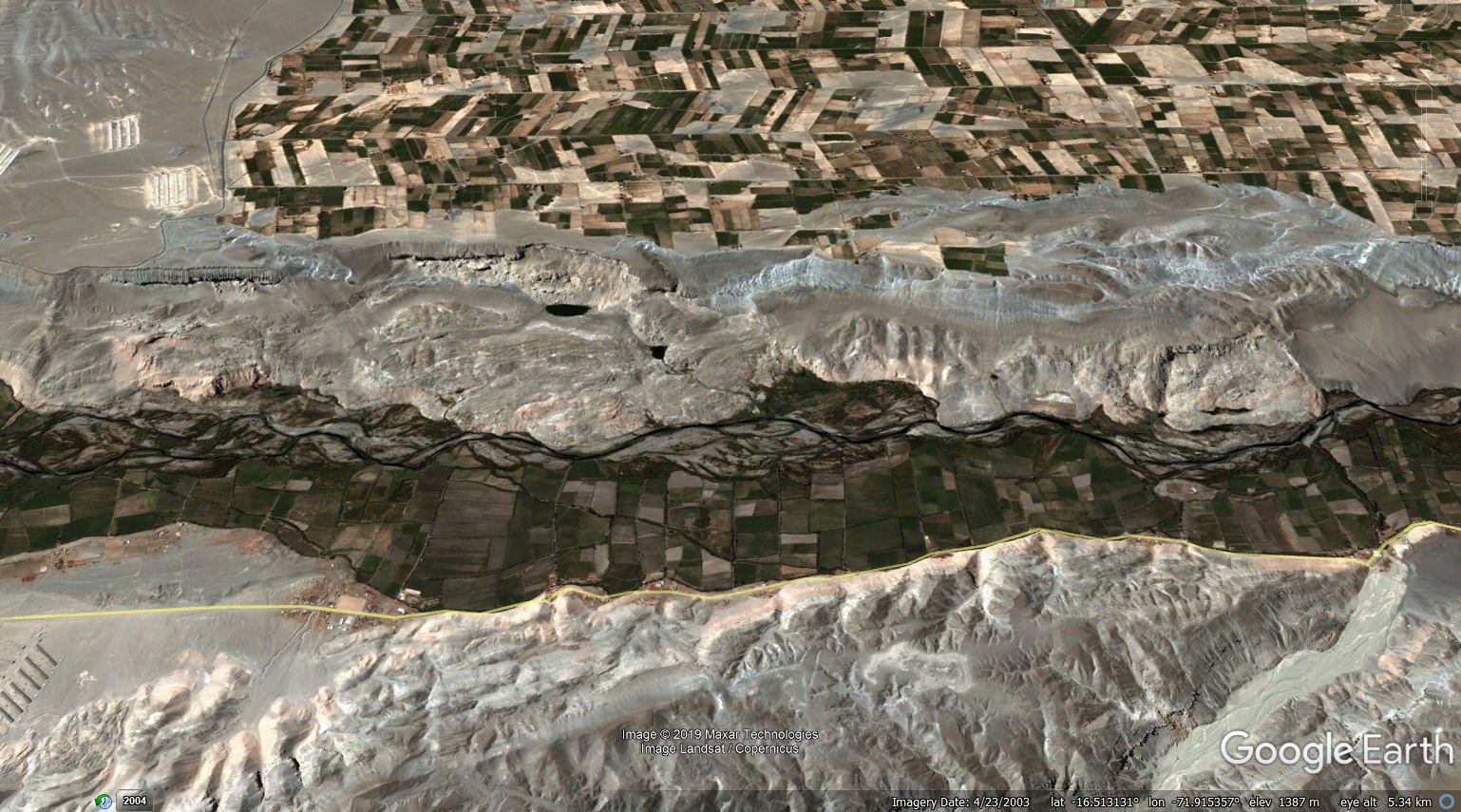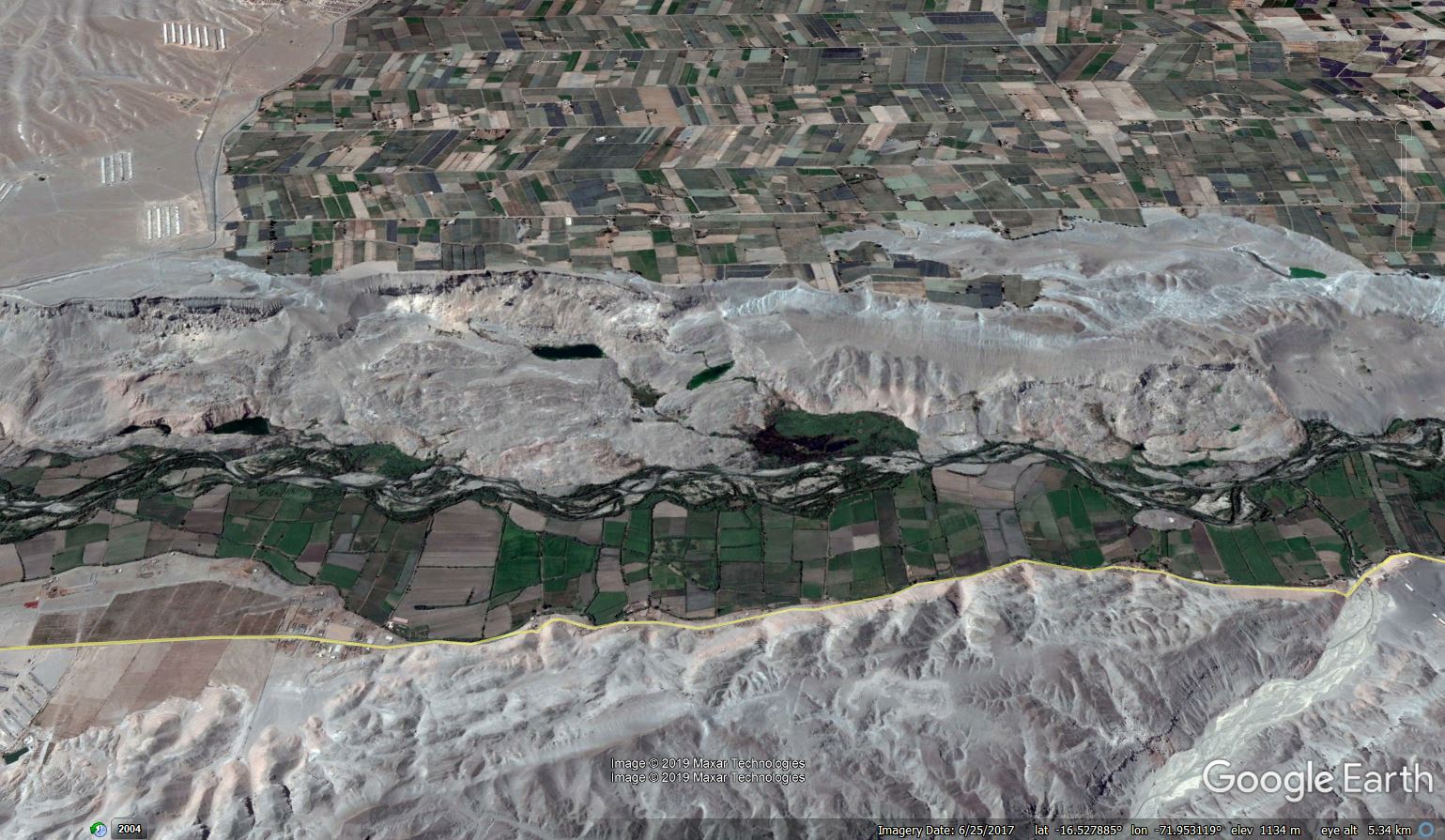15 January 2020
Major landslides caused by agricultural irrigation in Peru
Posted by Dave Petley
Major landslides caused by agricultural irrigation in Peru
It is well-established that irrigation by farmers can be the cause of landslides, especially in areas with low rainfall totals. A year ago I wrote about evidence that irrigation in Washington State in the northwest of the US has been driving landlsliding on river bluffs. This month, a very nice study was published in Nature Geoscience (Lacroix et al. 2020) that uses a long archive of satellite data to examine landsliding on river cliffs in Peru. The study area, the Vitor and Siguas valleys in southern Peru, is hyper-arid, which has meant that historically agriculture has been limited to the flood plains of the incised river channels. However, in the second half of the 20th Century, agriculture was extended onto the desert plains using irrigation to sustain the crops. This Google Earth image, of the Rio Vitor, shows the deeply incised (c. 200 m deep) channel, the agriculture on the flood plain, and the irrigation-supported farming areas on the desert plateau-

Google Earth image of the Rio Vitor in Peru, dated 23 April 2003.
.
The image also shows the extensive landsliding on the river bluffs below the areas under irrigation. Note that in two locations there are ponds at the foot of the rear scarp of the landslide.
Lacroix et al. (2020) have used a combination of declassified Hexagon spy satellite and SPOT 6/7 images to measure movement rates in the landslides. They found surprisingly high movement rates – in some cases total displacements of 400 m were recorded. In general, movement started about 20 years after irrigation was started, presumably representing the period over which pore water pressures developed. Thereafter movement was somewhat episodic, without an obvious driver from environmental drivers such as precipitation. Interestingly, the highest movement rates were recorded in the parts of the slope, presumably reflecting the locations in which pore water pressures are highest.
The development of irrigation driven landsliding on these river slopes can be clearly seen in the Google Earth imagery. The image below is the same area as that shown above, but this time the image is from 2017, 14 years later:-

Google Earth image showing landslides caused by irrigation in the Rio Vitor in S. Peru. Image dated 25 June 2017.
.
Very clear development of the landslides – for example the one slightly left of centre – can be seen. The head scarp has eroded back into the farming area, whilst the toe of the landslide has moved forward, claiming further fields. It is interesting to see many more ponds.
Interestingly, the authors note that further large irrigation schemes are planned in this area. Lacroix et al. (2020) suggest that further development of landsliding can be expected as a result.
Reference and acknowledgement
Lacroix, P., Dehecq, A. & Taipe, E. 2020. Irrigation-triggered landslides in a Peruvian desert caused by modern intensive farming. Nature Geoscience 13, 56–60. doi:10.1038/s41561-019-0500-x
I came across this article through of a very nice description of it in Eos by Jane Palmer:
Palmer, J. 2020. Modern farming kick-starts large landslides in Peruvian deserts. Eos, 101, https://doi.org/10.1029/2020EO138556. Published on 14 January 2020.


 Dave Petley is the Vice-Chancellor of the University of Hull in the United Kingdom. His blog provides commentary and analysis of landslide events occurring worldwide, including the landslides themselves, latest research, and conferences and meetings.
Dave Petley is the Vice-Chancellor of the University of Hull in the United Kingdom. His blog provides commentary and analysis of landslide events occurring worldwide, including the landslides themselves, latest research, and conferences and meetings.
Here is a world review on irrigation-induced landslides (from literature published in Chinese, English, and Spanish): https://www.mdpi.com/2073-4441/13/1/10